Your Planets
Portraits of the Planets
Aspects between Planets
The planetary ages
The planetary families
Planets in Signs
The Planets in comics


The phrase “alignment of the planets” has since the beginning of the 2010s been commonly used indiscriminately by all kinds of journalists, politicians, economists and other news commentators to designate a mysterious celestial configuration which would have a favorable influence on the course of an event temporarily remarkable or a major milestone in the short life of a prominent character. Note that in the Anglo-Saxon mediasphere, the expressions “alignment of the planets” and “alignment of the stars” are used interchangeably. This lack of differentiation reveals an unfortunate semantic confusion between planets and stars. Indeed, by definition, only the planets, mobile stars, can be the object of periodic alignments. Stars are distant celestial bodies that can be considered immobile, relative to planets, because of the imperceptibility, on a human scale, of the very slow movements that can bring them closer together or separate them on the scale of astronomical temporalities. which are counted in hundreds of millions of years. A good point for the mediacrats frenchies. But it is the only one because for the rest, they are like the Anglo-Saxons: they got it all wrong.
This astrolatric and superstitious frenzy touched the highest peaks of the French state. Thus, in an article published on 6th January 2017 in the business magazine Les Échos, of course titled “Should we fear the end of the alignment of the planets?”, can we read the following sentences: “It was in 2015. François Hollande congratulated himself on a perfect “alignment of the planets”. In astronomy, this phenomenon only occurs every ten or fifteen years. The President of the Republic, for his part, alluded to an equally rare economic situation: the improbable combination of very positive factors […] If the end of the alignment of the planets is therefore very real, its effects should for the moment remain measures. The main subject of concern in 2017 should rather be the rise in political risk, and its share of uncertainties. A climate that the markets hate.”
This article, which is only one example among a multitude of others affecting all fields, is emblematic of this phenomenon of ignorant abuse of language in several respects. In this text, it is above all a question of the favorable or unfavorable nature of an economic situation and its possible political impact. Let’s have some fun: the same sentences could have been used to evoke a succession of victories from a football team, randomly that of the Bleus: “It was in 2015. Didier Deschamps congratulated himself on a perfect “alignment of the planets”. The coach of the France team alluded to a rare sporting situation: the improbable combination of very positive factors […] If the end of the alignment of the planets is therefore very real, its effects should for the moment remain measured. The main subject of concern in 2017 should instead be the rise in the performance risk of the German Mannschaft, and its share of uncertainties. A climate that the sponsor Nike hates.” And it is a fact that the sports press also misuses this expression.
But back to the article Échos. His title, “Should we fear the end of the alignment of the planets?”, could have been that of an inept chronicle of the calamitous Élizabeth Teissier, former astrologer-sociologist graduated from the Sorbonne. We are here in the presence of a concentrate of alarmist and ignorant superstition: a mysterious “alignment of the planets”, the text of the article showing that the journalist who wrote it knows nothing about astronomical laws, could be “formidable”, but the effects of its end could remain “measures”. In short Guillaume Benoît, who wrote this text, does stupid alarmist astrologism without knowing it in the genre “there could be a catastrophe because of a characteristic configuration of the planets, but when this one ends it will not be so terrible”.
an astrologer lambda as ignorant as this follicular economist would have written that in a major media, the press would have immediately fallen upon him and, with a touching anti-astrological unanimity, would have called him a charlatan prophet. The rare paper-pusher mediacrats with a few elementary notions of astronomy would have even reproached him — and rightly so! — to talk nonsense about planetary alignments, which do not occur “than every ten or fifteen years”, but according to any other periodicities depending among other things on the identity and number of the planets “aligned”, of their grouping in a given angle, of their sidereal and synodic intercycles, of their right ascensions, declinations and ecliptic latitudes, etc. But here it is: it was an economist paper pusher who wrote this text, and, by the way, let us remember that contrary to what economists would have you believe, economics is not a science and much less an exact science (no more than astrology) despite the mathematical models it uses and abuses to make people believe the opposite despite its regular predictive failures.
Because you have to know it: the dominant economism has been based for two centuries on the preposterous hypothesis according to which the human being is a fundamentally rational being who is only motivated by the desire to increase his earnings as much as possible and/or to reduce its losses, these mechanisms giving birth to an entity named “the market”, which would ideally self-regulate through its own, mysterious and quasi-divine “invisible hand”. A conception of the world even more irrational than that of classical astrology. And yet astrology does not deny the irrational dimension, irreducible to any economic equation, of very many behaviors of human beings. Find the mistake…
It is striking to note that it is in the economic press that we find the most references to this mythical “alignment of the planets”. This is probably not a coincidence: for lack of being able to develop reliable predictive models, the pseudo-scientific economists seem forced, like vulgar fatalistic astrologers, to magically appeal to the periodicity of planetary configurations which they do not understand and of which they know nothing in an attempt to explain, rationalize and predict events whose current and future temporal characteristics escape them.
Now is the time to get down to business and define as precisely as possible what a planetary alignment is, an astronomical notion so vague and imprecise that one understands better, by analyzing it, why ignorant folliculars and chatterboxes use and misuse the metaphor associated with it: imprecision here is a semantic viaticum allowing to tell anything under a superficial veneer of explanatory rationality. Such is the fate of words diverted from their primary meaning in the mediacratic sphere.
In fact, the term “planetary alignment” can define two very different astronomical realities depending on whether it relates to a group of planets all forming conjunctions and contained in a reduced arc near a portion of the ecliptic, or to the disposal of a certain number of planets that do not all necessarily form conjunctions and can even be very far from each other, but seem aligned on the same straight line due to the strong inclination of the ecliptic on the horizon at a given period.
To clearly differentiate them, we will call the first type of alignment “cluster-alignment”, and the second “rectilinear alignment”. The alignment-cluster is characterized by the fact that the alignment can be more or less vertical when the planets grouped together are close to the horizon, and more or less horizontal when they are close to their upper culmination (see detailed explanations below). below). Rectilinear alignment is always more or less horizontal.
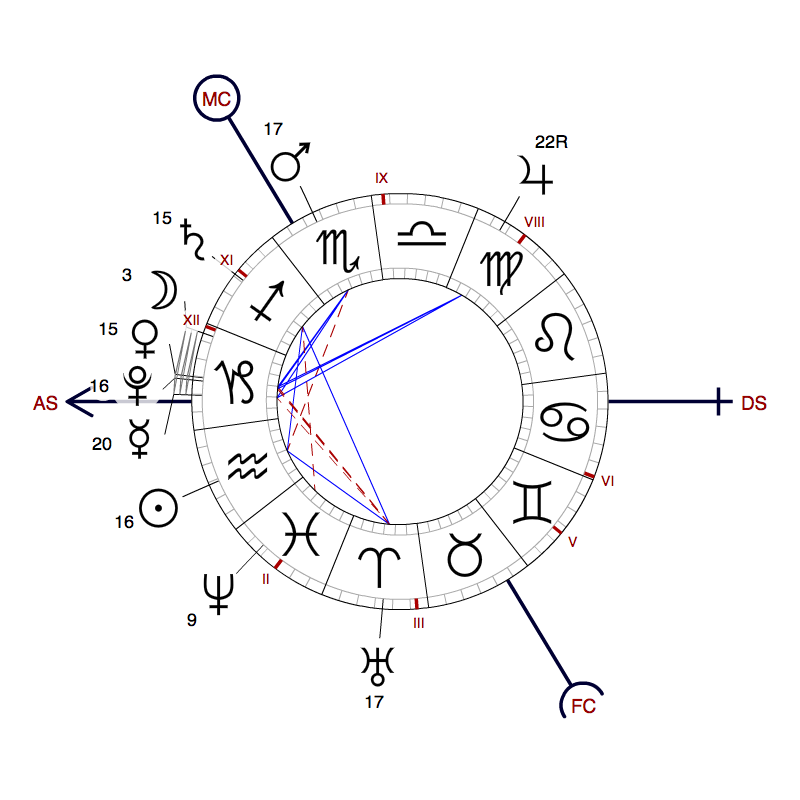 The most recent rectilinear alignment of the planets visible to the naked eye occurred during the period from 20th January to 20th February 2016. For the latitude of Paris for example, it is on 5/02/2016 at 7:15 OT that all the planets could be observed in the night sky. And in order for this phenomenon to be observed, it is necessary that the planets thus “aligned” are all located in so-called Signs of “long climb” (from 0° Cancer to 0° Capricorn) and whether the Rising Signs are Capricorn or Aquarius. For more information on this subject, refer to our article dedicated to the astronomy of the Houses.
The most recent rectilinear alignment of the planets visible to the naked eye occurred during the period from 20th January to 20th February 2016. For the latitude of Paris for example, it is on 5/02/2016 at 7:15 OT that all the planets could be observed in the night sky. And in order for this phenomenon to be observed, it is necessary that the planets thus “aligned” are all located in so-called Signs of “long climb” (from 0° Cancer to 0° Capricorn) and whether the Rising Signs are Capricorn or Aquarius. For more information on this subject, refer to our article dedicated to the astronomy of the Houses.
The inclination of the ecliptic plane (on which these planets are approximately located) with respect to the horizontal plane varies according to the terrestrial latitudes and the hours of the day. The figure below illustrates the phenomenon of “spin” movement of the ecliptic for a North latitude of 45° 11′ and an East longitude of 5° 42′, in 24 h and starting from the Ascendant at 0° Aries. Indeed, the local sphere being… local, the movements of the Planets on the ecliptic and their height in relation to the horizon vary according to the terrestrial latitudes.
We can thus see that, depending on the hours of the same day, the height of the Sign which culminates at the MC, the inclination of the ecliptic on the horizon and the azimuth (angle, in the horizontal plane, between the direction of an object and the direction of South — see the figure below) of the Ascendant Zodiac Sign.
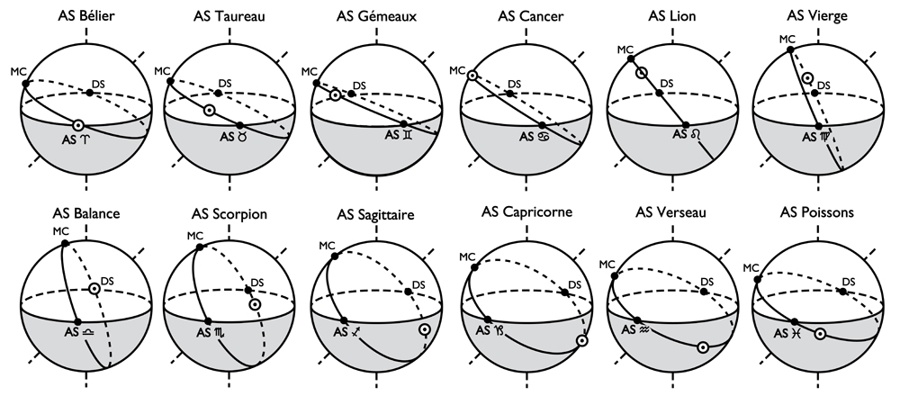
We notice that the ecliptic (circle through which the points AS-MC-DS-IC pass) is very low on the horizon when these are the Signs of “short climb” which rise on the horizon (Ascendant point), and in particular Capricorn which interests us in the first place, since it was he who was on the Ascendant during this rectilinear alignment. And when 0° Capricorn is the Ascendant point, the height of the ecliptic at the meridian is 34.47° above the horizon for an earth latitude of 45° North. By comparison and for the same latitude and for an Ascendant at 0° Libra (always refer to the figure above), the height of the ecliptic at the meridian is 68.45°.
This means that for an early Capricorn Ascendant, the curve described by the ecliptic, very inclined on the horizon for a terrestrial latitude of 45°, seems much less pronounced than for an early Aries Ascendant. Therefore, if all the planets visible to the naked eye are in Signs of “long climb” or in a Sign (Capricorn) following the last of these, Sagittarius (which is the case on 5/02/2016, since the Moon, Mercury, and Venus are in Capricorn, Saturn in Sagittarius, Mars in Scorpio and Jupiter in Virgo), the ecliptic arc on which they are located is so tilted on the horizon at that time that they appear aligned on a curve of such reduced amplitude that it can pass for a straight line… if you are not too careful about straightness and accuracy. In this case, amateur astronomers do not seem to be overly so. The figure below very schematically represents this rectilinear pseudo-alignment, does not claim it to be exact either (among other things because the Moon and all the planets are located there on the ecliptic, whereas in reality the Moon, with an ecliptic latitude of 5° 06′, lies a little above this curve). But this figure shows it very well:
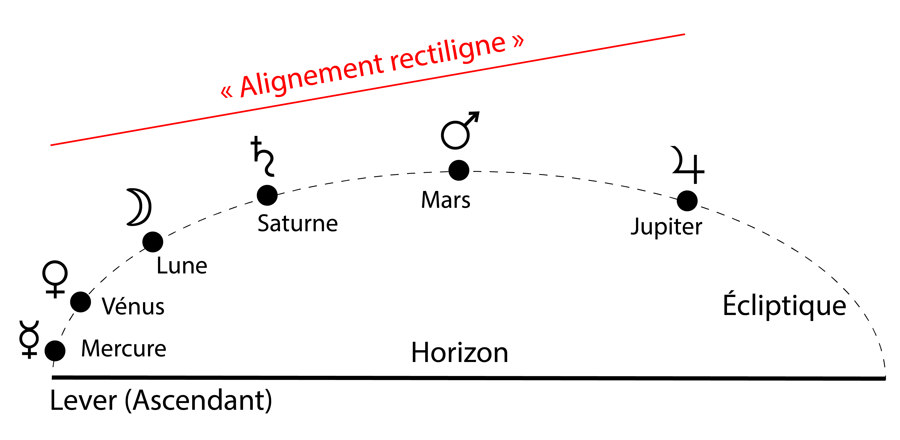
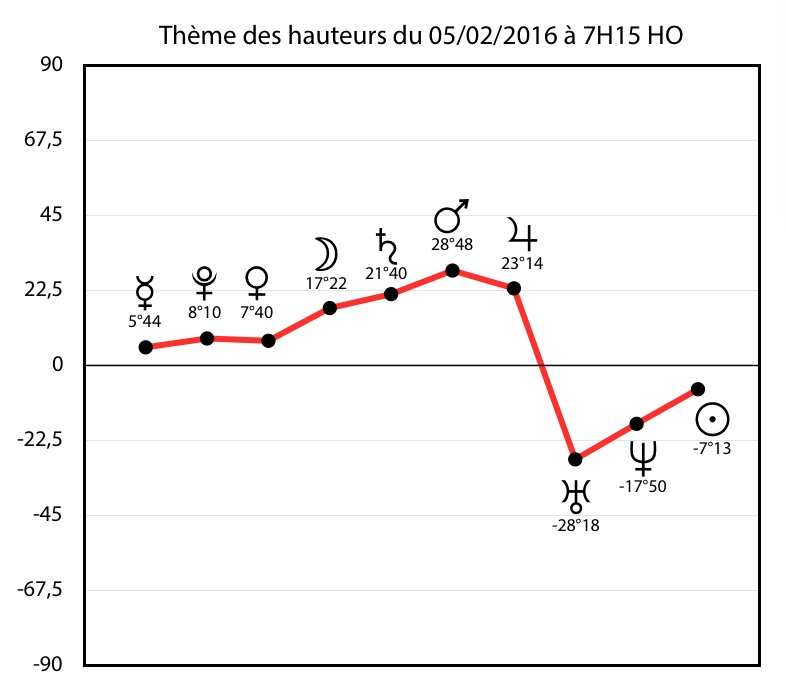 In this rectilinear alignment which is not and which extends over 118° 27′ degrees of arc, only Moon, Mercury and Venus form a conjunction (wide orb of 17° 24′). Saturn and Mars are separated by an arc of 27° 29′, Mars and Jupiter by an arc of 55° 05′. Apart from the fact that this succession of planetary positions is at that time on their diurnal arc (therefore above the horizon), which is not extremely rare, there is nothing rare about it and therefore from the media sensational.
In this rectilinear alignment which is not and which extends over 118° 27′ degrees of arc, only Moon, Mercury and Venus form a conjunction (wide orb of 17° 24′). Saturn and Mars are separated by an arc of 27° 29′, Mars and Jupiter by an arc of 55° 05′. Apart from the fact that this succession of planetary positions is at that time on their diurnal arc (therefore above the horizon), which is not extremely rare, there is nothing rare about it and therefore from the media sensational.
The figure opposite is another representation, more rigorous from the point of view of the accuracy of the planetary positions with respect to the horizon, but which does not take into account the distances of arcs which separate the planets from each other. This is the height chart, which is limited to noting the positive or negative heights of the planets with respect to the horizon, represented by the central line.
We observe, since this figure also takes into account the Sun and the planets invisible to the naked eye, that Pluto was part of this more or less rectilinear alignment (rather less than more) above the horizon, while Uranus, Neptune and the Sun were below.
These more or less rectilinear alignments of the heights are not exceptional and, as such, should not contribute to whipping the blood of mediacrats in search of hard-hitting astrolatric formulas. Finally, by way of comparison, here is, represented by the figure below, what the same succession of planetary positions included in an identical arc would have given (roughly, because I made this illustration at random) if the planets had found themselves in other Signs than those they occupied at that time, but this time at the rising of 0° Libra, the moment when, still for a terrestrial latitude of 45°, the point of the ecliptic at the upper meridian (MC for astrologers) is at a height of 68.45°:
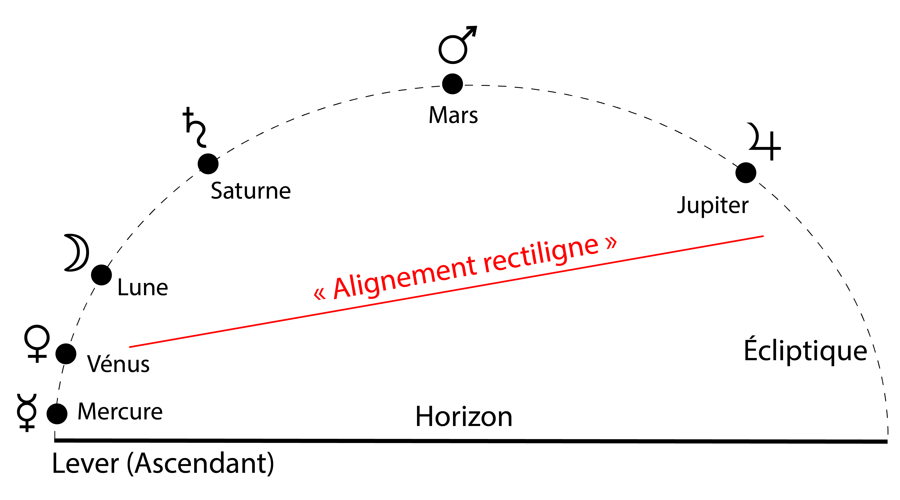
In this case, as we can see, it is strictly impossible, even in the mind of an amateur astronomer who is particularly undemanding in terms of straightness and accuracy, to evoke a rectilinear alignment: for an Ascendant at 0° Libra and a terrestrial latitude of 45°, the curvature of the ecliptic is then too characteristic to allow this kind of geometric fantasy. From these two examples it emerges that rectilinear alignments are astronomical micro-events of visual essence which only have meaning for the observations made by voyeurs of the sky at a given moment and for a given terrestrial latitude. The same configuration seen from an equatorial observation point would not make it possible to imagine any straight line around which the planets in question in this example could be aligned as best they could. In short, this kind of nickname “alignment” is not universal. This is not the case with alignment-clusters.
A planetary cluster-alignment (which in astrology is called a planetary cluster, without using the term alignment) is nothing but a sequence of conjunctions geocentric between several planets grouped within an indefinite separation angle. If all the planets are aligned, if all the conjunctions are exact (angular difference of 0°) and if the alignment is too, which never happens, it is not an alignment, but one and only exact conjunction. The alignment, on the other hand, supposes an angular difference (an orb) greater than 0° between each of the grouped planets: they are then located next to each other.
Where does a planetary cluster-alignment begin, where does it end? What are the lower and upper limits by which it can be defined? The lower limit is of course that of the exact conjunction. As for the upper limit, it is indefinite. Depending on the number of aligned planets and the orbs allowed for their successive conjunctions, an alignment or cluster can unite planets in successive conjunctions very close to each other (a few degrees of arc) or further apart (up to several tens of degrees of arc), knowing that each conjunction can have its particular orb, more or less wide or narrow.
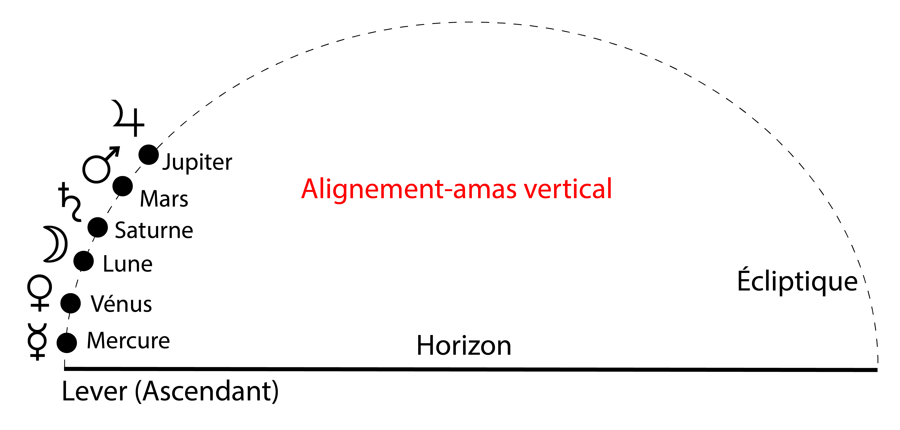
Astronomically, there is no physical law defining the maximum angular deviation for a planet to be considered in conjunction with another. Nor, therefore, does one exist to define the maximum arc extent within which a number of conjunct planets can officially be considered aligned. This is the reason why the term planetary alignment is hardly used except by amateur astronomers, who have a very elastic and ocular conception of its extent, which is limited only by what their telescopes allow them to see. observe, by the personal idea that each of them has of what an alignment is and by the rare and therefore spectacular character of those which occur in an arc less than 10° or 15°. This mathematical limit is perfectly arbitrary, since there are many cases where the successive conjunctions which constitute the cluster-alignments can extend over 30° to 60°.
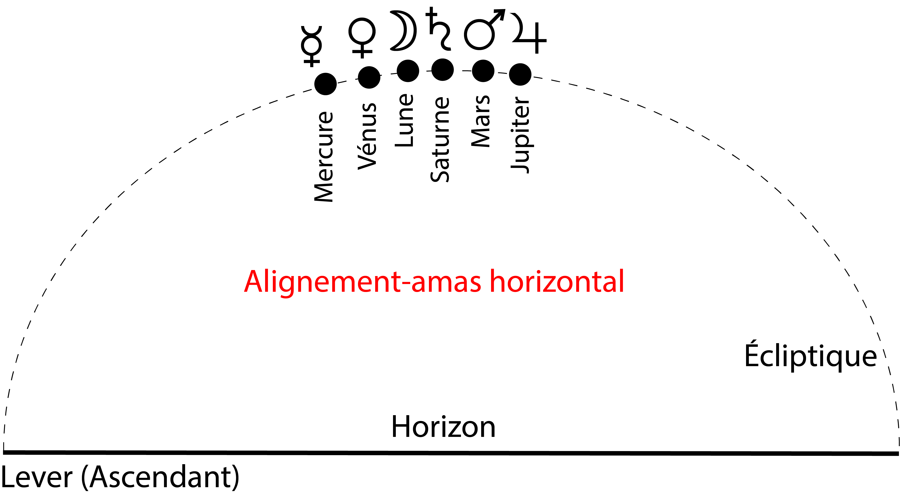
For the terrestrial observer astronomer or astrologer, this celestial string which unfolds on or in the immediate vicinity of an arc of a circle can be close to the vertical (the planets are then located one above the other), or horizontal (the same planets are in this case next to each other). The maximum vertical alignment occurs when the planetary conjunctions are close to the horizon, therefore in the zones of their rising (direction of the East) and their setting (direction of the West). As for the maximum horizontal alignment, it is observed when they are close to the upper or lower meridian. Therefore, during its geocentric cycle of 24 h, the same alignment can be vertical or horizontal, depending on whether the conjunct planets rise, set or culminate in the South or North.
The relative verticality or horizontality of an alignment-cluster depends on its extent, that is to say on the orb of the successive conjunctions which constitute it. The closer an alignment-cluster is, the closer the planets composing it are to verticality when they are close to the horizon (Ascendant-Descendant axis for astrology); the more it is extended, the more this relative verticality appears for what it is: a fraction of an arc of a circle small enough to look like a straight line. The effect is the same for the upper and lower culmination alignments (Middle-of-the-Sky-Back-of-the-Sky axis).
Example No. 1. The sky charts below were calculated for 01/05/1881 at 07:00 OT at a latitude of 45° 47′ north. The one on the left represents the planetary positions projected on the ecliptic plane in the celestial sphere, the center of which is that of the Earth. The one on the right represents the same positions, this time in the local sphere, whose center is the eye of the observer. In these two representations, we observe the existence of a relatively tight alignment-cluster (20° 54′ of arc in the celestial sphere on the left) composed of Mercury, Saturn, Jupiter, Sun, Venus and Neptune, i.e. not less than 5 planets. By allowing ourselves larger conjunction orbs (which we do not hesitate to do here), Pluto and the Moon are also part of this cluster of 8 planets in an arc of 50° 17′. The Sun being at the center of this cluster, the planets are not visible at the end of the eyepiece of a telescope since the star of the day immerses them in the night of its light. So much the worse for amateur astronomers who are obsessed with lucky numbers, who will not be able to quibble about the excess of these 20° 54′ or 50° 17′ of arc that they have not had the opportunity to observe.
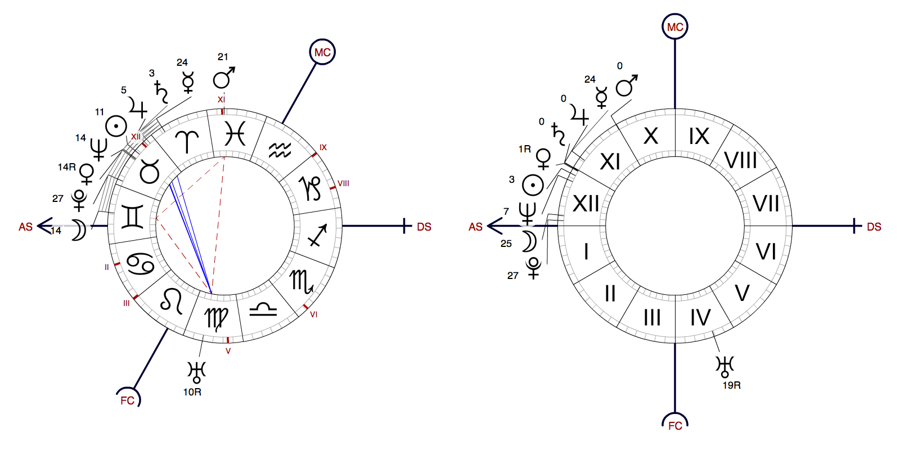
Since it is a question of observation, note in passing that in the sky chart on the left, Pluto is above the Moon, while in the one on the right, it is the opposite. This is normal: the representation on the left is based on the projection on the ecliptic plane (apparent geocentric orbit of the Sun) of the positions of the Moon and the planets, without taking into account their ecliptic latitudes, i.e. say their positive or negative height relative to this plane. The representation on the right is based on the real positions of the Moon and the planets in the local sphere, which take into account the real positions, i.e. the ecliptic latitudes (−2° 11′ for the Moon and −13° 14′ for Pluto).
Because of its position (23° 26′ of arc above the horizon), this alignment-cluster cannot be perceived or considered as approaching the vertical: if the Sun was not in its center, so if it could be observed, the planets would not be seen as clearly above each other on an approximate line segment, but next to each other, in a succession of conjunctions increasing in height in accordance with their arrangement as a segment of an arc of a circle which appears more clearly as the alignment-cluster moves away from the horizon and approaches the meridian.
Example No. 2. The sky charts below were calculated for 08/05/1929 at 07:45 OT. This time it is a much more extensive planetary alignment-cluster, since Uranus, Venus, Moon, Sun, Jupiter and Mercury form successive conjunctions included in an arc of 57° 30′. Moreover, it is not a planetary alignment strictly speaking since the Sun and the Moon occupy the center of this cluster, they are not planets and the Venus-Uranus conjunction is not joined to the Mercury-Jupiter conjunction. What is of no importance here: the essential lies in the fact that it is indeed a large-scale alignment-cluster and that the orbs of the conjunctions are much larger than in the previous case. Can we still consider that such a planetary configuration is an alignment? Yes, if we refer to its fundamental definition: a succession of conjunctions. But because of its extent and for the time of this observation, it is impossible to obtain an alignment close to the vertical or the horizontal: the stars are far too scattered.
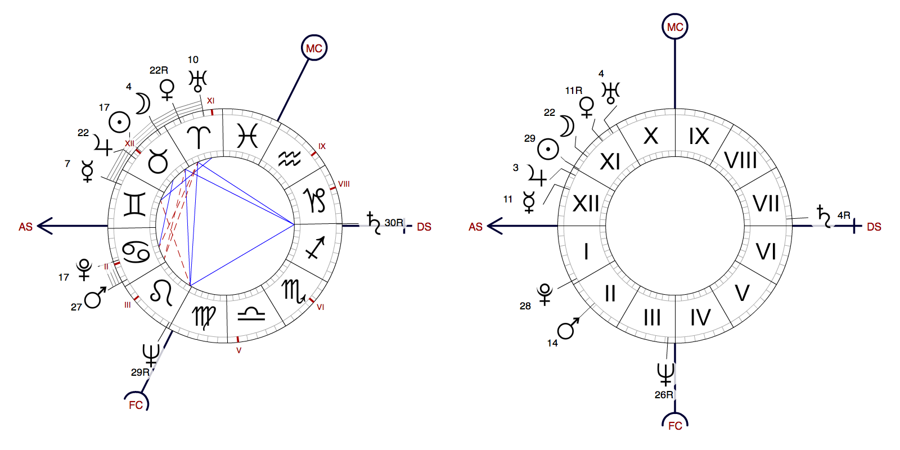
Contrary to what the follicular of the Échos, the phenomenon of alignments, clusters or rectilinear lines, “only occurs every ten or fifteen years”. The periodicity of the alignments-clusters depends on the number of planets which constitute them and on the combination of the periodicities specific to their respective intercycles (from 88 days for Mercury-Pluto to 490 years for Neptune-Pluto passing, for example, by the 2, 23 years of the Mars-Jupiter intercycle or the 45.36 years of that of Saturn-Uranus). This set produces a whole range of different alignment-clusters, the vast majority of which do not occur every 10 or 15 years.
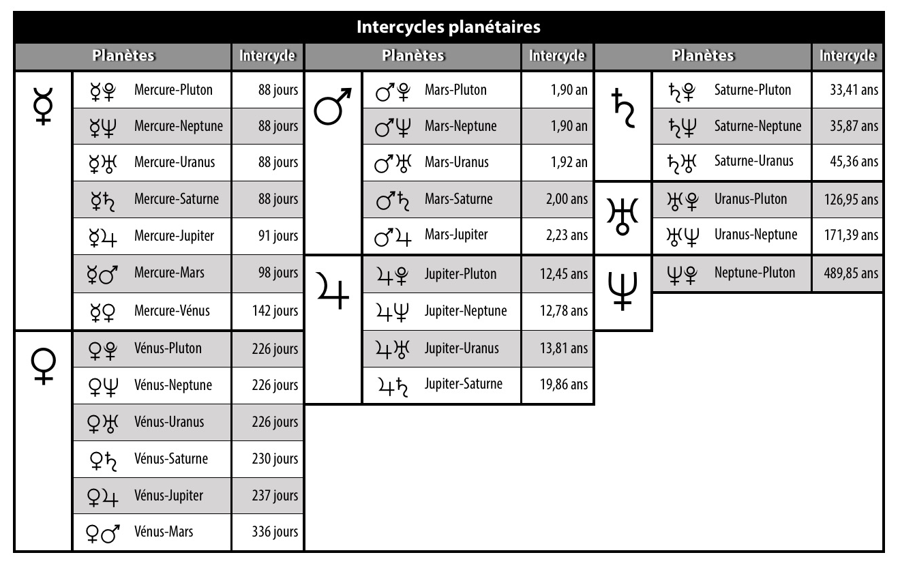
A simple conjunction between two stars cannot constitute an alignment-cluster. To be worthy of this uncontrolled appellation, the planets must be at least three. Normal: if it is easy to draw a straight line between two points, it is less easy between three, unless the three are on the same plane, which is not obvious when they are located on an arc of a circle. The minimum alignment-cluster is therefore composed of a triple conjunction, a phenomenon which is not rare in the case of fast planets, but which is much more so in that of slow ones. Amateur astronomers therefore prefer alignments-clusters made up of at least four planets: it is rarer, therefore more spectacular and they can say “I was there!” if they were able to point their telescopes in their direction during the period of variable duration in which they occurred. Their happiness is at its height if it is a Venus-Mars-Jupiter-Saturn alignment-cluster: two rapids and two slow ones visible to the naked eye at once, provided that the apparent magnitude of Venus makes it impossible to observe her three co-aligned. The quintuple alignment-cluster Mercury-Venus-Mars-Jupiter-Saturn also has its followers, but they are extremely rare, given that the very small Mercury is not then visible although being present, how we can be both present and invisible.
Due to the different inclinations of their orbits on the ecliptic (thus their declinations) and the characteristics of their synodic periods (time taken by a planet to return to the same Earth-planet-Sun configuration), it is astronomically, and therefore astrologically impossible that all the planets of the solar system can rigorously align.
The Institute of Celestial Mechanics and Ephemeris Calculations of the Paris Observatory has nevertheless calculated — excluding Pluto, due to dwarfing — after how long the remaining 8 planets could align in clusters more or less correctly according to the least common multiple of the synodic periods. Result: theoretically, the 8 official planets of our solar system have a possibility of aligning approximately at least once every 147 billion years. If we include Pluto, it’s still much, much longer. The problem is that the life expectancy of the solar system, and therefore of the planets likely to align, is linked to the life expectancy of the Sun, which is approximately 10 billion years according to the current knowledge. Given that the Sun is already halfway through its existence, it is obvious that the alignment of the 8 official planets is almost impossible, and even more impossible if we include Pluto.
As a consolation prize, know that we can fall back on the case of imperfect and partial alignments-clusters of planets visible to the naked eye, which occurs relatively frequently, a certain number of these being then grouped together in the same region of the sky.
A maniac of round numbers, Jerard V. Uptain, had fun calculating when alignments of planets visible to the naked eye had occurred (therefore excluding the trio Uranus-Neptune-Pluto) in an angular gap less than 10° for a period going from −4000 to 2750, which is quite a while. From the year 0 of the Christian era to the end of the 21st century, he found only four dates: 04/10/332 (8° 46′ arc), 26/06/710 (5° 39′ arc), 17/09/1186 (arc of 8° 44′) and on 08/09/2040 (arc of 9° 17′). Of course, these ultra-precise dates have no meaning: they are only worth what the arbitrary and exclusive 10° of orb that allowed them to be selected are worth. It will be noted (see following figures) that in two cases out of four, these alignments occurred when the Sun was very close to them or at the center, which makes them unobservable phenomena, and that in the fourth, in 710, the observation, which could only have occurred around 20:15 UT, i.e. after sunset and before that of this cluster-alignment, could not have taken place, given that at At this twilight hour, the sunlight below the horizon was still strong enough to make it impossible to see these planets. Anyway, at that time, it would also have been necessary to have an excellent view, since the first astronomical telescopes (which only had x 3 magnification) only appeared in 1590 or 1608 depending on the sources.
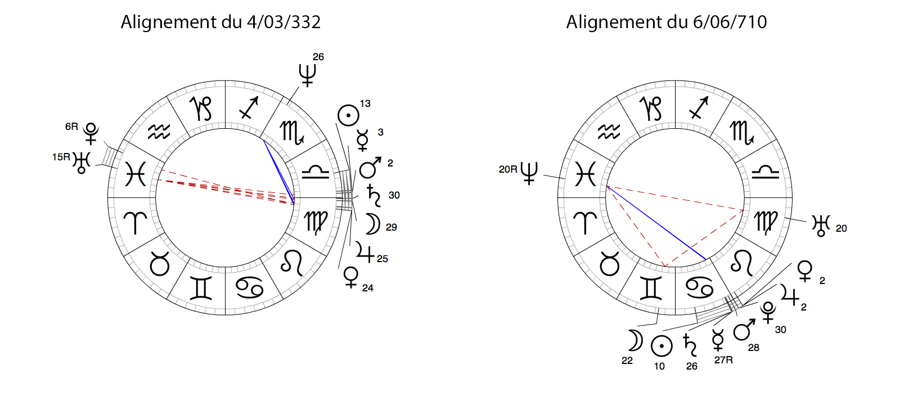
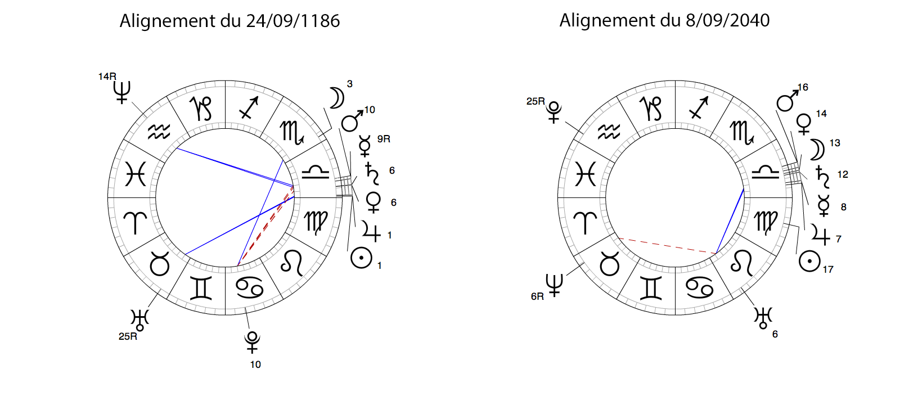
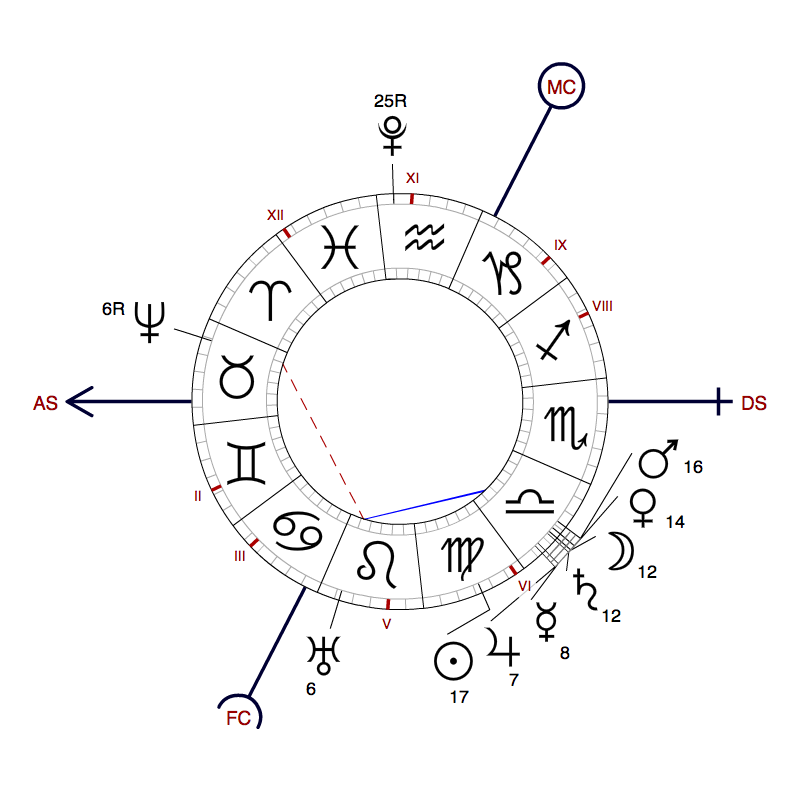 The next alignment-cluster bringing together all the planets visible to the naked eye in close conjunction (therefore less than 10° angle) will therefore take place on 8th September 2040. The figure opposite, calculated for 20:30 UT, represents this astronomical event: in the lower right, you can observe an alignment of Moon (which is not a planet, but Earth’s satellite), Mercury, Venus, Mars, Jupiter and Saturn grouped together (successive conjunctions) in orb of 9° 17′ in the Sign of Libra. At the time of this observation, Neptune will have just risen, disdained by the Institute of Celestial Mechanics and Ephemeris Calculations of the Paris Observatory, and for once, journalists will be able to speak of partial and imperfect alignment (since they are not all on the same line because of their ecliptic latitudes) of a few planets grouped together without saying anything like vulgar traditionalist astrologers.
The next alignment-cluster bringing together all the planets visible to the naked eye in close conjunction (therefore less than 10° angle) will therefore take place on 8th September 2040. The figure opposite, calculated for 20:30 UT, represents this astronomical event: in the lower right, you can observe an alignment of Moon (which is not a planet, but Earth’s satellite), Mercury, Venus, Mars, Jupiter and Saturn grouped together (successive conjunctions) in orb of 9° 17′ in the Sign of Libra. At the time of this observation, Neptune will have just risen, disdained by the Institute of Celestial Mechanics and Ephemeris Calculations of the Paris Observatory, and for once, journalists will be able to speak of partial and imperfect alignment (since they are not all on the same line because of their ecliptic latitudes) of a few planets grouped together without saying anything like vulgar traditionalist astrologers.
The alignments-clusters, which are the only ones that count in astrology, come under the general regime of conjunctions of the Aspect theory: their nature is therefore both consonant and dissonant. Depending on their extents, the presence of all or part of the planets that constitute them, the orbs allowed for conjunctions and the consonant and/or dissonant aspects they receive from other planets outside the cluster, they can be subdivided into sub-clusters. For the details of these operations, consult the protocol for prioritization of our online software Astrosoft.
▶ Astronomy of planets
▶ Cosmography
▶ Aspects theory and practice